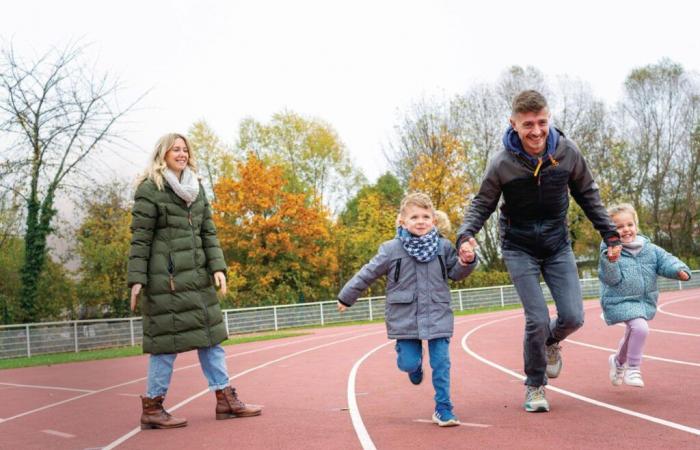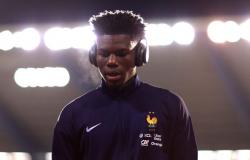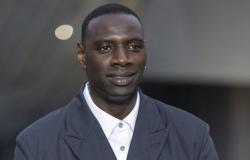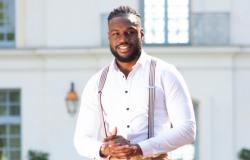Sitting, surrounded by Spiderman, Ironman and the Incredible Hulk, Sacha plays with his favorite superhero, Captain America. Their stories are similar. Originally weak and weak, Captain America transforms into an invincible fighter after a doctor inoculates him with a magical fluid. Sacha, suffering from Duchenne muscular dystrophy, also received the “super-soldier serum”, as Hélène and Édouard Villemin, his parents, call it. A gene therapy drug, developed as part of a protocol by Généthon. The operation took place on December 7, 2022, Sacha was 6 years old. Two years later, the child climbs trees, hops, climbs, has completed his first kata in karate… and is growing up without clinical signs of his pathology. “This treatment is one of the best hopes for curing Duchenne disease,” explains Frédéric Revah, general director of Généthon, “even if, scientifically, we must remain cautious. »
The destiny of the Villemin family changed on August 29, 2018. That day, Sacha celebrated his 2nd birthday. After playing with friends, the child feels unwell. “He was trembling and livid,” Hélène remembers, “as if he were having an epileptic fit. » In the emergency room of Strasbourg hospital, a blood test reveals a high level of CPK (creatine phosphokinase). Sign that the muscles, heart or meninges are suffering. “To identify the cause, Professor Vincent Laugel, head of pediatric neurology, offered us a genetic analysis,” says the mother. We came home worried. » A few days later, the diagnosis fell like a blow: Duchenne muscular dystrophy, a degenerative disease, due to an anomaly in the DMD gene, discovered in 1986. The latter is responsible for the production of a protein, dystrophin, necessary to the proper functioning of muscle fibers. At Duchenne, this is not produced at all. Without it, the muscles become damaged with each contraction and end up being destroyed. None of them are spared: neither those used to breathe nor the heart.
The symptoms are terrible. “Children are in wheelchairs before the age of 12,” explains Frédéric Revah. They need respiratory assistance before the age of 20 and leave us between 20 and 30 years old. » The ground is slipping away from under the feet of Hélène and Édouard: “Our son suffered from an extremely disabling illness, without any treatment and fatal,” recalls Hélène. We were devastated. » Their daily life becomes a relentless battle.
Heavy treatment from the age of 3
From the age of 3, Sacha had to take corticosteroids and undergo physiotherapy sessions to limit the loss of muscle strength and orthopedic deformation. Every night he wears leg braces. Every six months, he carries out checks with Professor Laugel. Hélène takes the opportunity to discuss with the pediatric neurologist the protocols that her son could benefit from. The latter tells them that a trial has shown its effectiveness on dogs but that it will still take a few years before it can be administered to humans.
How can we be patient when there is an emergency? “For decades, thanks to the courage of parents of sick children and donors, we launched the Telethon and created our laboratory, the Généthon, with its own research teams,” explains Laurence Tiennot-Herment, president of the AFM. -Telethon. We made the strategic choice to turn to gene therapies. » This option consists of providing the affected organs with a “healthy” version of the gene which will compensate for the deleterious effects of the deficient gene. To get it into cells, it needs a transporter. However, nature already has a tool at its disposal that allows it to infiltrate organisms: viruses. It could be that simple. The only thing is: the DMD gene is the longest in the human genome. No virus can contain it in its entirety. “We had to recreate a shortened version, which retains all the functionalities,” explains Frédéric Revah. The fruit of several decades of research. »
The rest after this ad
The Telethon, “a buoy to hold on to”
For the families concerned, “the Telethon is a buoy to which we cling,” explains Hélène. A way to keep your head above water.” The creation, in 1987, of this television event, thanks to the fierce will of parents, opened up the field of possibilities. Previously, no laboratory was interested in Duchenne disease. The scale of the donations gives rise to hope. “On the sets, our children all have this incredible strength to express: “Maybe for me it is too late but I fight for others. One day we will win. So give!” », underlines Laurence Tiennot-Herment, mother of Charles-Henri, who died in 2003.
Among the Villemins, despite the unbearable wait, life continues as it does. At the time of Sacha's diagnosis, they wanted a second child. “We gave up at first,” remembers Hélène, “before telling ourselves that the illness should not take everything from us. » The equation is delicate. If they give birth to a boy, he has a 1 in 10 chance of having the defective gene but this can be detected by amniocentesis. If it's a girl, she will probably be spared: the disease hardly affects them. In their soul and conscience, Hélène and Édouard follow their desire. At one month pregnant, the ultrasound reveals the sex of the baby: female! Albane, Sacha's sister, is now 4 and a half years old.
“I’m 35 years old. I wasn't even born when researchers were already working to save my child's life.”
In 2021, the protocol identified by Professor Laugel can finally be applied to young patients: a first little French child receives a dose of gene therapy. But the side effects are obvious, the trial is suspended while the protocol is adapted. On November 14, 2022, the phone finally rings at the Villemin house. ” Good morning. It's Professor Laugel. I have very good news…” Sacha, who ticks the forty selection criteria, joins the process. On December 7, in a sterile room, surrounded by his mom and dad, the boy was connected to an IV. “A powerful moment of meaning,” recalls Hélène, “who realizes: I am 35 years old. I wasn't yet born when researchers were already working to save my child's life. » Sacha is the heir of a fight. In its infusion bag are concentrated forty years of research. “Are you ready,” his mother asks. “Yes, and even my guardian angel,” replies the boy. Together, they wait for the “super-soldier serum” to flow drop by drop through his veins. Four and a half hours later, the operation finished, the little fighter jumps from his medical bed and runs to the door of the room. ” What are you doing ? his mother wonders. – I’m checking if the treatment works! » he replies.
Four weeks after the injection, Professor Laugel carries out control tests. Hélène says: “I only see his eyes because of the surgical mask but his look says a lot when he tells me: “I think his calves are more supple…”” A month and a half later, it was 'bedtime. Ash heads towards the stairs to climb into his room. An act which, until then, required a superhuman effort: helped by his arms clinging to the railing, he hoisted himself from one step to another. “I see him go up in one go, alternating right foot and left foot,” Hélène is surprised. Then he turns to me with a big smile. » To be sure she hadn't dreamed, she asked her son to go back downstairs and start again. And this time she films it. The video will go around the scientific world. This gesture, as banal as it seems, demonstrates that the disease is no longer gaining ground, or even losing ground! Not only is Sacha doing better, but he is recovering his motor skills and making progress.
In 2024, he participated in the Olympiads organized in the town of Obernai, where the family lives. Running, long jump, shot put… He also ran cross country with his class. “I did twenty laps around the schoolyard,” he says. He enjoys children's games like any other kid his age: slide, rope ladder, suspension bridge, zip line… Certainly, his life is punctuated by “an almost military rigor,” describes his father. The disease doesn't take a break. So neither do we.” Taking corticosteroids in the morning and medications in the evening to counter the side effects of the first: osteoporosis, weight gain, mood swings, strong emotionality, limited growth, etc. Daily stretching session, physiotherapy once a week alternating with hippotherapy. Sitting on Filou, a large white pony, Sacha works on his posture, muscular strength and endurance, and his overall motor functions.
“These results trigger a real emotional tsunami among parents of children suffering from Duchenne disease,” admits Laurence Tiennot-Herment. It is a symbolic victory, a pivotal moment for those who have death on their heels. Hence the importance of making a donation so that a parent never again endures the death of their child! » These therapeutic advances must now be consolidated over several years and in dozens of patients before they can be developed on a large scale. Money is the sinews of war. Because if Sacha's story sounds like a miracle, it is far from being one.






